Insights into the marketing technology 2020 and beyond is an online survey conducted by WARC in association with BDO and the University of Bristol on more than 750 brands and agencies to understand their current and future marketing plans for martech tool use, budgets and barriers to growth. This research was conducted on brands and agencies located in North America, the UK, Europe, and APAC.
Moving on, let’s take a more in-depth look at what this 2020 Martech Insights? what are the marketing trends ? and what the future of Matech 2020 is?
You must be familiar with the concept that marketing usually focuses on developing a healthy relationship with customers and satisfying their needs.
Then you must also be knowing that this could not have been possible without technology.
Indeed, these marketing technology tools and needs in marketing are directly proportional to each other. The more the tools, the more their need.
However, due to the modernization of people’s language with time and this marketing technology word clubbed to form a portmanteau, MarTech.
Well, in simpler terms, MarTech is basically a short version of marketing technology. This mixed name concept can be witnessed in various other sectors, such as AdTech (Advertising Technology), a term used in the world of advertisement field.
Well, well, wait! Before hitting the numbers and data, let’s first try to understand the basic concepts of Martech.
What is MarTech?

Source: Chiefmatec
Like any other term used in the Software world, this Martech is also a term used by the software techies and marketers who plan, execute, and measure their business campaigns.
The planning, execution, and measurements are usually carried out with the help of Martech tools.
These tools help you in streamlining and analyzing your data and provide you with various methods or options to reach out to your target audience and keep them engaged.
What are the MarTech Tools?
Martech Tools ranges from content strategy tools designed for different media to data management tools, analytics, and attribution tools.
Some examples of tools are Photoshop, WordPress, MS- Excel, etc.. To sum up, there are about 7040 Marketing tools readily available for you on a global scale, according to Chief Market Technologies. And these vendors vary from start-up specialists to established providers.
Well, speaking of tools while browsing about this vast topic, did you ever come across the term Martech 5000 and wondered what it stands for?
Like, you and I know what I love you 3000 stands for but Martech 5000?
Well, in 2017, there were around 5000 solutions available globally for commercial purposes are these were nicknamed as “MartTech 5000”.
According to Growth, the top 10 market technology tools are:

Source: Growth
Getting back to the basics, let’s understand what a stack is in the retail world.
What is meant by Martech Stack?
A marketing technology stack is an archive of all the technology tools that companies or marketers leverage for improving their retail activities or processes.
In simpler terms, this stack is a collection of the software used by the company for retailing purpose.
I guess you have brushed up your basics, let’s now get into details about insights into the marketing technology aka Martech.
In this article, you will find the current trend, state, use, and future expectations of the marketing technology industry.
Ages of Marketing technology

Source: Chiefmartec
Our tech market’s first era began in the early 21st century and was in existence until 2012.
As you can see, 2012 saw the upleap in the tech market, and the era was called the early age of martech. This early age of martech saw the introduction of new marketing tools into the lives of businesses and companies.
Later till 2017, the graphs of software and tools usage hit an excellent steep, and that age was called the first golden age of martech.
But from the 2018 year, you can observe a bend in the graphs of tech usage.
2018 to 2020, a reckoning in the market is predicted. Therefore the era is called the reckoning age of martech.
However, past 2020, it is said that marketing technology will see a drastic change and will be higher than ever.
Martechs law:

Source: Chiefmartec
As you know, marketing is bizarrely complex and is evolving at a breakneck pace. Martec’s Law is a genuine dilemma for everyone in the corporate industry.
Hold on… Before I talk about how bizarre the market is. Let me tell you what the Law is.
What is Martech Law?
Martech’s Law is a graphical representation of the change in the market and change in the organizations.
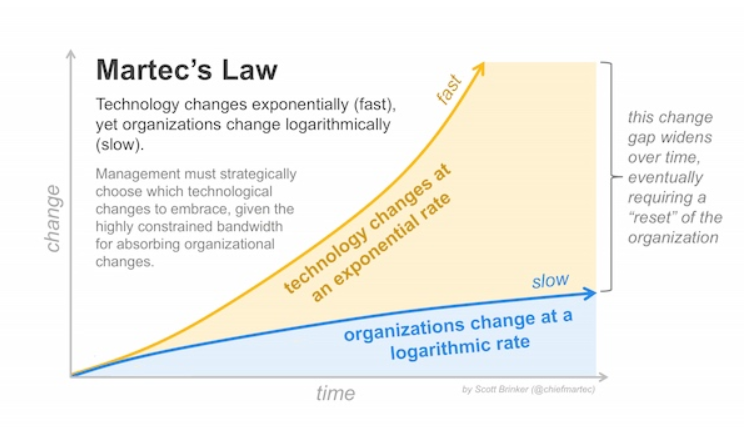
Source: chiefmartec
According to this Law,” Technology changes exponentially, but organizations change logarithmically.”
That means the rate at which the technology is updating is faster when compared to the rate at which organizations are adopting the technology.
In other words, the rate at which the organizations are adapting to the new technology is slower than the rate of updation in technology.
Insight of MarTech 2020:
Technical software is developing over time. According to Marketing Technology 2020 Landscape Supergraphic reports by Chiefmartec, the number of solutions in 2011 was 150; from there, it boosted to 7,040 solutions according to Landscape Supergraphic 2019.
The growth of the solutions from the past eight years can be seen in the image below
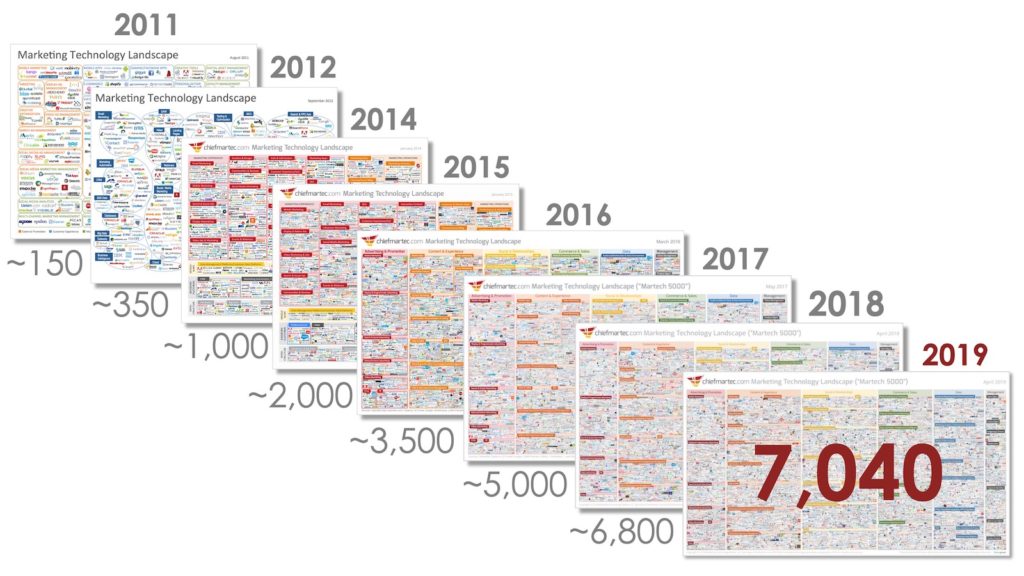
Source Chiefmartec
The estimated market size of the Marketing Industry in North America and the United Kingdom’s (UK) is as follows:
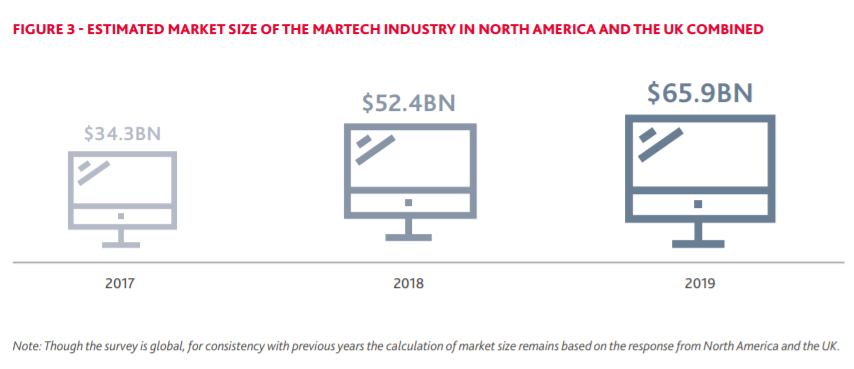
Source: Martech 2020: and Beyond
From the above image, you can see How the market spending has doubled from $34.3 billion in 2017 up to $65.9 billion in 2019 just in a span of two years. The data is combined spending of North America and the UK exclusively.
However, you can observe a massive difference between the increased amount of spending for each individual annum. The increase in marketing size in 2018 is 18.1 BN, and for the current year, it is 13.5 BN.
This means the corporate spending on marketing software has decreased by 4.6 BN in comparison to 2017.
The percentage of overall retail budget spending on marketing technology:
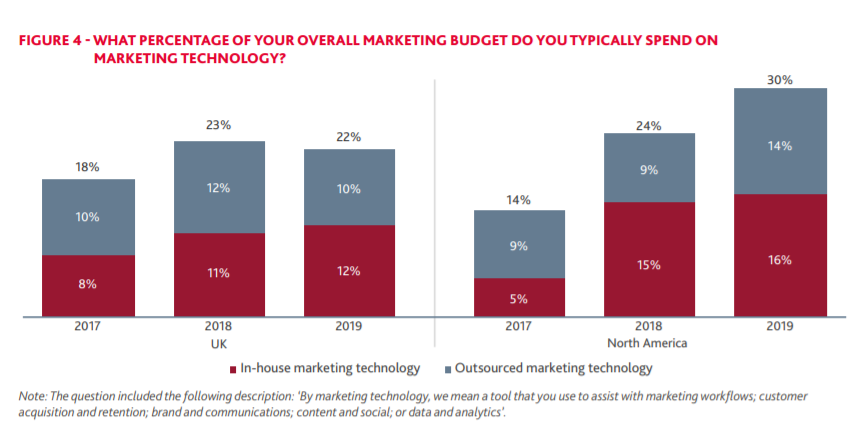
Source: Martech 2020: and Beyond
The data, in the above image, is split by the proportion of companies spending on in-house and outsourced marketing technology.
As you can see, the results show a rapid growth rate in the spendings in North America
region while the UK has remained steady.
On average, all the brands in North America and the UK are spending approximately 26% of their budgets on software when compared to 23% last year.
That means there is a 13% increase in martech budgets since last year. However, in comparison to 2017 Martech values, there is slight evidence of a decline in the future of the market.
When coming to in-house sourcing and outsourcing by these companies, there has been substantial discussion in the industry regarding the usage of in-housing of tech and optimized utilization of services by brands from their agency partners over the years.
However, what the results suggest is, in the North America region, there has been an increase in both in-sourcing and outsourcing by the brands.
However, when you look at the data of the UK, there has been an evident drop in the outsourcing of resources but a 1% increase in the in-sourcing.
Marketing Technology budget change over 12 months:
The martech budget change of clients by 2020:
The 750 brands and agencies on who the research is done have two opinions on the client’s budget. On analyzing the combined results of these 750 brands, 43% of the brands feel there would be an increase in the client’s budget over 12 months by 2020, 53% of the brands feel there wouldn’t be any change as the clients will still keep their budgets fixed for the annum. However, only 4% of the brands feel there would be a slight drop in the set budgets of the clients.


Source: Martech 2020 and Beyond
When you try to look at the results of the analysis for individual regions, each region has its perspective.
Before moving on with the further analysis of the data, you should remember that the analysis reports of Europe excluding the UK while the others are of the whole region.
All other regions except for Europe strongly believe that most of the client’s budget would remain constant while in Europe, 53% of the brands believe there would be a significant increase in the budgets of the clients.
The martech budget increase of brands by 2020:
When the brands were questioned about their budget increase over the next 12 months, the results were somewhat like this:

Source: Martech 2020: and beyond
As you can see, each percentage of brands has its proposals for the budget increase.
On average marketing technology, 2020 budgets by brands are:
- 22% believe that their budgets might increase by 0-5%.
- 26% estimate their budget increase between 6-10%.
- 21% calculate their brand budget increase to range in between 11-15%.
- 15% of the brands feel theirs might increase between 16-20%.
- 9% of the brands say their budget will increase between 21-25%
- 6% of all brands estimated their budgets to increase by more than 25%.
However, from the results, you can analyze that Europe, including the UK, has the highest percentage of brands, on average, 9.5%, which predicts their budgets to be more than 25% of the current budgets.
While North America has no companies which estimate to spend more than 25%, however, it has the highest number of brands calculating to increase in between 0-5% on their budgets.
How has increased investment in marketing technology affected the companies’ Media Spend?
With the development of Chatbots, Artificial Intelligence, SEO tools, and other corporate tools, it has become easier for marketers which media is most effective for their use and promotions.
In the last year’s survey, it was found that the marketers had decreased their market spend when they invested in software tools. But for 2019, marketing technology, the market trends have changed.
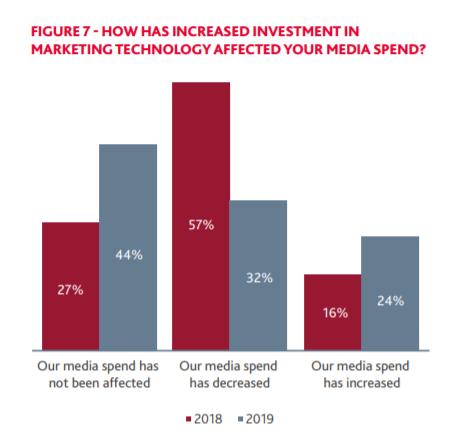
Source: Martech 2020 and beyond
From the above data, you can understand how the market trends have changed in comparison to 2018.
Though for about 44% of the brands, their media spend has not been affected, for 32%, it has decreased whereas there was a 57% decrease in 2018.
That means there is a difference of 25% when compared. However, a significant increase of 8% is visible on the media spend from 2018 to 2019.
What do the marketing trends, marketing technology budgets and marketing sizes for 2020 suggest to…..
Brands?
On a global basis for brands the marketing technology, market trends and sizes suggest for the development of in-sourcing resources as well as to maintain good relations with outsourcers too.
Thought the budgets of companies by 2020 are predicted to increase, you can see how more than half of the budget is spent on resourcing.
Hence the companies should focus more on developing their in-source resources or train the pre-existing staff to integrate and upskill their methods and ideas of resourcing.
This doesn’t mean you tend to lose your relations with outsourcers. Incase if the insource resources crash, the only option you have to get your job done is through outsourcing. Hence it is equally important to maintain a balance between insourcing and outsourcing.
Agencies?
From the observations of inhouse and outsourcing future marketing trends, you can see that there is a little momentum in In-housing resources among the respondents.
Hence there is an excellent opportunity for you to grab. You can use this opportunity as an advantage and win back most of your clients, who are about to consider in-housing or have recently shifted to in-housing.
However, winning back is not as easy as you think.
It rarely happens that you go to your client, explain to him difficulties of in-housing, and boom he is impressed and gets back to you.
To impress your client and win him back, you should sell your values according to “COW.”
Now wondering what this COW is?
Well, COW stands for Creativity, Objectivity, and Wider perspective.
Hence, when you are explaining your resources to the client, always try to be creative, objective, and try to have a wider perspective of branding and culture.
Technology vendors?
As you can see, the possibility of an increase in budget spending, there is always a scope of improvement for your tech vendors.
All you have to do is to ensure that your goods and services can facilitate creativity, are easy to operate, and solve the concerns of both brands as well as agencies.
Media Owners?
If you are a media owner and are looking at the data analysis, I bet you must be feeling happy.
Compared to last year, data this year has a piece of positive news for all media owners because there last year had a great decrease in media spent while this year’s research says there is an increase.
For you, the key to making money out of this is by focusing on the importance of data of the brands and agencies as well as keeping yourself transparent.
Now, if you step ahead and prove your effectiveness and relevance to brands concerning the context of increasing usage of technology platforms, that’s it you get clicked just like that.
Now, let’s look at the current usage and capabilities of marketing tools.
Current Use and Capabilities of Marketing technology:
Marketing tools provided by established organizations are where the brands and agencies find their use.
The following are the marketing tools currently in use by most of the brands on a global level.

Source: Martech 2020 and beyond
From the above data, you can analyze various categories of tools used by companies for marketing.
In 2018, the usage of tools was
- Email – 85%
- Social Media – 75%
- CRM – 68%
- Analytics – 64%
- Content Strategy – 63%
- Mobile – 58%
- Data Management – 58%
- Ad Tech – 57%
- Commerce, Lead management, sales – 56%
- SEO – 47%
- Market Automation – 41%
- Experience Optimization – 37%
- Collaboration – 28%
- None of the above – 9%
Source of the data: Martech 2019 survey by WARC and Moore Stephens
By comparing both 2018 and 2019 data, you can see that for some tools, there is a drop in their usage while some have picked up the graphs.
Though you can observe a negligible difference between the rise of Analytics, Measurements and Insights, Mobile, Data management, and Ad tech’s graph, you can find a significant rise of 3% among Market automation and SEO. A 5% rise in usage of experience optimization can also be seen. But, in the case of collaborations with other software, there is an increase of 9% in comparison to that of 2018.
However, you can see that, and there is a 3% downfall in the usage of Commerce, lead generation and sales, and Customer relationship management (CRM). While coming to Emails, there is a significant drop of 6% in the usage in 2019.
However, the future market trends also suggest that there might be a huge fall in the usage of Emails as only 14% of the population among the 750 brands plan to use it in the next 12 months. Comparatively collaboration usage can be seen to fall as 38% of the crowd have no plans in using the tools.
How can you develop the best MarTech Strategy?
When the Brand respondents of the Survey conducted by WARC in association with BDO, and University of Bristol were asked about the skills they look into while hiring the marketing function for their company the top priorities were somewhat like this:
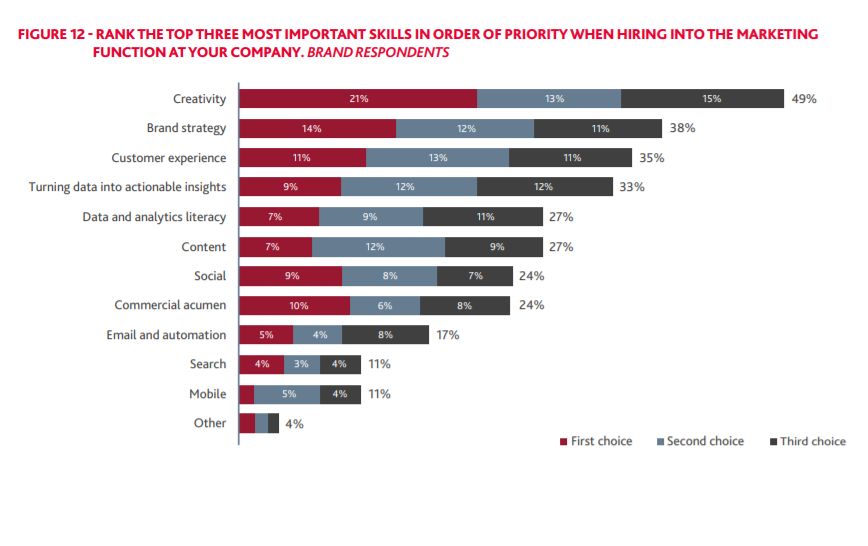
Source: Martech 2020 and beyond
As you can see, the most important criteria for the brands is creativity. On average, 49% of the brands prefer their marketing software to be creative. Later they look at the brand strategy and then the customer experience.
So similarly, even you should have a clear picture of what you need for your brand. Hence planning a martech strategy is very essential.
Here are some great tips for you to develop the best marketing strategy for the future market trends:
Analyze what you need:
Along with the growing market, new tools are launched every day. It is always tempting to get the best tool or a high-end tool. Every organization, just like yours, wants to have the best.
But what will you do with a tool which is of no use to you? It is just like a person with hearing aid buying a high-end version of headsets.
Hence, always sit with your team and analyze which tool is easy for them to work on and to give fantastic results.
Check for Upgradations of the tool:
Now, you know what you want and started to use it. It is giving the best results. But, with the change of time, tools also need to be upgraded for more optimization.
Hence, keep looking for up-gradation of the tool or alternative sources for tools that are easier to adapt and give optimized results for your brand.
You can save your time of research about new tools and use product hunt for the same.
Understand the role of the tool:
Why do you need a tool? Why can’t you do everything manually?
I know the answers, I was just playing around.
You usually need a tool because it serves several purposes that are important to your business team.
First, they help you in understanding your customers through data and analytics.
Second, they help you in automating processes so you can use that data to work more efficiently.
And third, they help you in making the customer experience even more personal and meaningful.
Hence when you are using tools, make sure that it serves at least one of the purposes. If your tool is not serving any of the purposes, I say ditch it and shift it to a useful tool.
Know what your clients look for:
Having a tool, analyzing the numbers or data will not fetch you anything until the client is satisfied. Hence when you are choosing a tool or planning a strategy, always keep clients persona in mind.
To know what your clients need to look for leads from the customer experience department and choose strategies accordingly.
Keep your data up to date:
Always remember, no matter whichever product services your companies provide, you must have your database. The database helps you understand more about the market; it’s functioning and customers’ persona, which helps you and your company develop to the next level.
How are marketing technology and customer experience related?
When the brands were asked about how important is customer experience optimization for their company? The results are:

Source Martech 2020 and beyond
As you can see, 57% of the population feel customer experience is very important, and 39% feel it is important. Hence on average, 76.5% of the brands and agencies feel customer experience is somewhat important for them.
What is the customer experience?
Customer experience is nothing but the feedback from the customer. The feedback can be in any manner. It can be the impression on your brand, product, or your services.
For most customer-based companies, the customer is the king.
Technologies used by the brands to learn about customer experience:
According to the research, as you can see, Most of the brands use Customer relationship management and social media management the most to get customer experience.
It’s not always necessary that you should also use what the top brands use. Here are some customer experience tools you can use for your company for better results.
Customer experience tools are:
1. Customer review suggestion box:
No one knows what is working and what is not better than your employees. So, first, start from your own office. You know, like charity begins at home, feedback also should start from your own office.
There might be a possibility that if you, the boss, is asking about a review, no one would dare tell negatives.
So drop a suggestion box where the employee’s name can be anonymous, and you get the genuine review.
2. Customer surveys:
Well, well, yes, customer surveys. From your database, you can find out your brand loyals easily, and also you can find brand switchers.
Pick them up and send surveys via online mails, or if you are in the same area, try to meet them up. You can have a little chat about their experience with the brand and then conduct a survey.
3. Social media listening tools:
If you feel that surveys, the suggestion box is too much, and you don’t wanna do it, then you can always turn to technology for help.
Social media listening tools help you monitor what your customers are looking for. It includes the top searched keywords, your brand products, their reviews or comments, your competitors, and many more.
Now you must be wondering where to get these tools? Don’t worry; we have a solution to every problem of yours.
There are an unlimited number of tools out there based on your preferences, for reference Hubspot, Hootsuite, Sprout Social are few tools from where you can start.
There are other Customer experience tools available in the market that fulfill your preferences, and they are IBM Tealeaf, Satmetrix, WalkMe, Khoros, Podium, Whatfix, and on and on.
By reading the above information about marketing technology and trends, I bet you must have understood what it is about and how are the current market trends.
Well, now let’s look at the future.
With 2019 almost coming to an end, it’s time we take our experiences from it and prepare for the future 2020.
Future of Marketing Technology 2020 :
The most used technology in the current marketing strategy these days is IOT- Internet of Things, 38% of the population among the brands use IOT as their technology in marketing strategy. 26% of them plan to use it in the next 12 months too.
Next, catching up technology is Virtual Reality, aka VR, 26% currently use it, and 24% plan to use in the coming 12 months.
The other analysis you can find in the figure below.
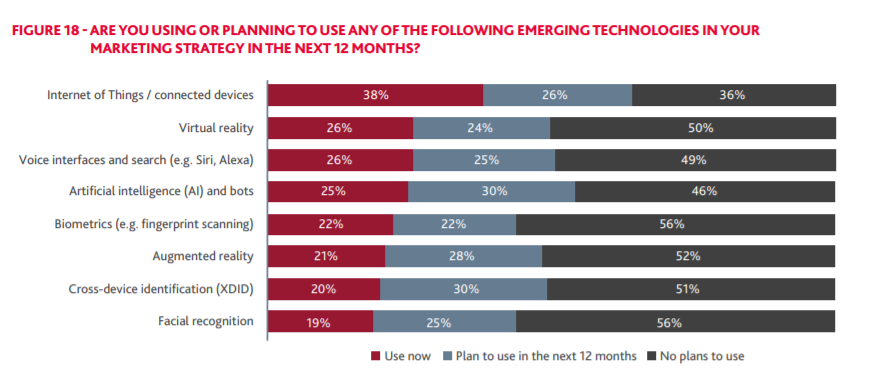
Source: Martech 2020 and beyond.
As you might be aware of the fact that along with changing times, technology is also evolving.
So, What will happen in 2020?
This is probably going to be the future of Marketing technologies, aka martech:
- Companies will optimize to Voice Search
- Companies’ dependence on Google Analytics will decrease.
- IOT technologies will top the business
- Brands will look for alternative communication channels.
- Businesses will no longer be built on one channel
- Personalization will be the new market trend
#Voice Search Optimization:
Though the research states that the voice search usage in the next 12 months will not be more than 25%, another search, according to ComScore states, over 50% of the future searches in 2020 will be in the from voice search.
Hence, companies to rank on top have to optimize to voice search.
Here we are not just talking about Google Assistant, Siri, Alexa. We are talking about voice searches beyond these.
One such personal best is Jetson.ai. Never heard about it?
Well, Jetson.ai is a voice assistant, which helps in voice shopping.
You don’t have to buy a device; all you need to do is simply connect it to your Amazon’s Alexa or Google Mini.
Then upload the menu and shop.
Voice Shopping in the U.S.is estimated to reach $40 Billion in and $5 Billion in the UK by 2022.”
-OC&C STRATEGY CONSULTANTS
Another wonderful thing about jetson.ai learns from the customers and customize it accordingly.
That means, If you are ordering a particular item from the same store over and over, it understands it, and for the next purchase, it makes it easy for you to order.
# Why will dependency on Google Analytics to decrease?
I am sure that every company at one point or the other must have used Google Analytics or is currently using it.
If you have used Google Analytics, you must be aware of how it functions.
If not, here is a brief intro to it. Google Analytics is basically a web analytics service. Google offers it. It helps you to track and report website traffic as a platform inside the Google Marketing Platform brand.
If you ask me if this Google Analytics is not accurate for research? I would say No.
Now, if you ask m if there is something wrong? Still, it’s no.
I bet your next question will be, do people, not like it? Of Course, no, who wouldn’t like a free tool to check Website traffic.
Then why will it be replaced? Let me give you a living example of smartphones.
Nokia phones were considered the best. Even you must have used it at some point. But with time, smartphones came in and replaced it.
People like you and me preferred smartphones cause work got easy and optimized.
Similarly, with Google Analytics. Over time new updated tools and software are emerging, and Analytics has become the conventional method of data analysis.
Nowadays, there are things like repeat purchases, upsells, down sells, and checkout bumps are seen. On top of that, there are various ways in which you can generate revenue for your online business, like partnerships, or webinars.
As a result, it has caused companies to start using analytics solutions that match their database better, for example, Amplitude. Or something more convenient than that.
In the end, all you are seeing is a big push into business intelligence.
In 2020, you will get to see more and more companies adopting these business intelligence solutions. Due to budgets, they might as well shift from paid ones to free ones like Google Data Studio.
If you have no idea about Data Studio, then I suggest you start getting an idea now.
It is easy for you to pass in all of your business and corporate data into one place.
For example, you can pass in more complicated data from your Facebook ad campaigns into Data Studio with ease as it would be a bit difficult task to perform with Google Analytics.
#How IoT will top the businesses?
As mentioned earlier, 38% of the population among the brands use IOT as their technology in marketing strategy. 26% of them plan to use it in the next 12 months too.
According to a report by Statista, the Internet of Things (IoT) connected devices installed worldwide in 2020 will be 30.73 billion. Currently, in 2019, it is 26.66 Billion.
Which means there would be a rise of 4.07 billion in IoT.
If you have no idea about what IoT is then, The internet of things (IoT) is nothing but the data you share over an internet connection.
In technical terms, IoT is a growing set of technologies based on devices that could share data via an internet connection.
Hence, companies will have to look into this for better optimization, and it is estimated according to a report by Statista that by 2015, this IoT would reach 75.44 billion.
That means 48.78 billion rises from the current use.
#Why will brands look for alternative communication channels?
The most conventional communication channel used by corporates is Email. You and I also use it for our marketing purposes.
In fact, email marketing is one of the E-Commerce business ideas and SEO ideas.
The only problem with emails is conversion rates are low. Buyers, most of the time, do not check inboxes or only look for important ones and skip promotions. Hence it is becoming challenging for companies to only stick to emails.
Hence, companies are looking forward to alternative business channels for better conversion rates, which are effective in turning their leads into customers.
Some alternative communication channels are Chatbots, Customer call centers, toll-free centers, and push up notifications.
# Why will business no longer be built on one channel?
In previous years, a lot have companies have been built on a single channel, like facebook, quora, etc.
Facebook uses the email address book as its channel. Whenever you log in for the first time, you must have seen a pop up suggested friends or import email addresses from facebook.
Similarly, Quora is built on SEO channels. It helps companies ranking on search engines.
But, marketing these days is not unidirectional. It is heading fast towards marginal gains.
If you want to win the market, then you must use all the channels possible for business. Hence marketers will shift to use multiple channels to build their businesses or rank number one.
#Why personalization is important in the future?
Personalization is an SEO trick to grab the attention of your customers. There are two types of personalization to a website:
- Themed personalization
- User personalization
Themed personalization:
This is what you do to customize your website according to a festival. Like recently, we celebrated Halloween. So you must have customized your website to a Halloween theme.
Google always personalizes itself to such events. It makes the users happy and attracts them.
Well, if you do not know how to customize your website, you can use organized themes for helping you with customization.
User Personalization:
This is an important point, especially in the field of online marketing. Let it be your ads or products you sell. You should always know your demographics.
User personalization is what you can find Amazon or Flipkart doing. They observe your shopping trends or recent searches. Later, when you use their services, they will show you related items.
Based on your recent searches, here are some suggested products. A message appears, and we find all our related items.
Now, what will happen if this is not there? If personalization was not there, then you or I can get suggestions for baby clothes or dog food.
Well, if you have a baby or a dog, it will be useful, but I don’t have a baby or a dog, so its a spam to me.
But if you give me some search related to footwear- oh, I love browsing footwear and keep on buying them even if I don’t need new pairs- I will browse and definitely buy at least one pair.
So, personalization helps in business growth and attracts customers.
Now, if you ask me, why is it important? In future people will get so busy that they will not have time to look into anything. If you personalize your products according to buyer persona and showcase them on top of the websites or ads, the chances are high that they will end up purchasing some goods or the other.
You might have definitely been hearing about some of the above points or might feel they are irrelevant to you, but this is the future of marketing technology 2020.
Martech is not a piece of cake. You also must have been facing barriers in technology for marketing. However, here are a few topmost barriers for Marketing technology 2020.
Barriers for MarTech:
According to the report, MarTech 2020 and beyond, the brands and agencies have different views on the barriers of marketing.
According to the brands, 50% of them feel budgets will be the top constraint in 2020 marketing. Still, agencies have a different view; among them, 56% feel understanding the technology will be a constraint for marketing technology 2020.
Here is the data analysis of barriers for both brands and agencies
Image:
Source: Martech 2020 and beyond
Conclusion:
On a whole account, Marketing technology 2020 is going to see a lot of ups and downs. But for you, if you have confusion or dilemma about what to do, where to start, how to start, you can always contact us.
Most things mentioned above are either things that you have been hearing for a long time or have never heard about. But whatever it is, it is in the future, and if you want to survive, you should be prepared.
We would always love to hear your views on the marketing trends 2020 and what you think about your future. Do give your opinions in the comments section below or contact us.
We hope that this article was of excellent help to you in understanding marketing technology and 2020 trends.







